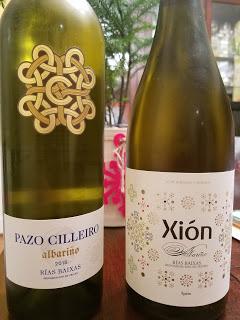 Looking for an alternative to Chardonnay or Sauvignon Blanc? Then check out Albariño from Rías Baixas, Galicia - situated in the northwest corner of Spain. The DO was created in 1980, but when Spain joined the EU in 1986 the DO was changed to simply Rías Baixas as EU laws did not recognize a DO named for a single grape variety. I don't know why. In order to be labeled Rías Baixas, the wine must consist of at least 70% Albariño - and with the amount of this grape grown, a rather easy goal. The denomination also permits six other types of wines which includes the Rías Baixas Albariño - 100% Albariño from any sub-region.
Looking for an alternative to Chardonnay or Sauvignon Blanc? Then check out Albariño from Rías Baixas, Galicia - situated in the northwest corner of Spain. The DO was created in 1980, but when Spain joined the EU in 1986 the DO was changed to simply Rías Baixas as EU laws did not recognize a DO named for a single grape variety. I don't know why. In order to be labeled Rías Baixas, the wine must consist of at least 70% Albariño - and with the amount of this grape grown, a rather easy goal. The denomination also permits six other types of wines which includes the Rías Baixas Albariño - 100% Albariño from any sub-region.According to Rias Baixas Wines, DO Rías Baixas encompasses five distinct sub-regions. Ribeira do Ulla is the newest (formed in 2000) and is the most northern region. Val do Salnés is known as the birthplace of the Albariño grape. This is the original and oldest sub-region and it's fingers reach out into the Atlantic. Soutomaior is the smallest of the sub-regions and was registered in 1996. Soils are light and sandy over granite bedrock. Condado do Tea (The County of Tea) is named after the river Tea, a tributary of the Miño River which separates the border with Portugal. O Rosal also resides against the Miño River -- adjacent to the Atlantic. Because of the high rainfall and humidity grape vines are widely spaced and trained on stone pergolas and a wire trellis called a “parra". These parras can reach up to seven feet tall, allowing breezes to prevent mildew and to promote even ripening. During harvest, workers must stand on grape bins in order to collect the grape bunches.
Despite the high rainfall amounts, Rías Baixas vineyards are blessed with ample sunshine - averaging over 2,200 hours of sunshine per year. This sunshine in conjunction with the cooler climate provides an environment for high natural grape acidity. Albariño wines are also known for their floral and mineral character, most likely impacted soil composition within Rías Baixas. The bedrock is primarily hard granite with a top layer of mineral-rich alluvial (a combination of clay, silt, sand and gravel) formed from deposits eroded from running water.
Bodegas y Vinedos Attis Xion Albariño (Rías Baixas) - ($20) This wine displays the traditional combination of white fruit, citrus, saline and racy acids combined with an underlying texture. Albariño meets Sauvignon Blanc.
Bodegas Muriel 2015 Pazo Cilleiro Albariño (Rías Baixas) - ($20) Produced from grapes grown in the Val do Salnés, this is a fresh and lively wine, plenty of citrus and weighty stone fruit, and balanced acids. Albariño meets Chardonnay.
